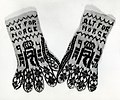File:WW2 Norway Red pointed cap knitted mittens national protest symbols Andre verdenskrig tyskokkupert Norge Ulovlige nasjonalsymboler rød topplue nisselue strikkevotter med H7 Haakon VII mønster Alt for Norge etc Lofoten Krigsminnemuseum.jpg
From Wikimedia Commons, the free media repository
Jump to navigation
Jump to search

Size of this preview: 800 × 533 pixels. Other resolutions: 320 × 213 pixels | 640 × 427 pixels | 1,024 × 683 pixels | 1,280 × 853 pixels | 2,560 × 1,707 pixels | 5,193 × 3,462 pixels.
Original file (5,193 × 3,462 pixels, file size: 3 MB, MIME type: image/jpeg)
File information
Structured data
Captions
Captions
Add a one-line explanation of what this file represents
Summary[edit]
| DescriptionWW2 Norway Red pointed cap knitted mittens national protest symbols Andre verdenskrig tyskokkupert Norge Ulovlige nasjonalsymboler rød topplue nisselue strikkevotter med H7 Haakon VII mønster Alt for Norge etc Lofoten Krigsminnemuseum.jpg |
English: Photo taken at the Lofoten War Memorial Museum (Norwegian: Lofoten Krigsminnemuseum) in Svolvær, Norway's largest exhibition of uniforms and smaller items related to the Second World War, Nazi Germany and the German occupation of Norway 1940 – 1945:
Norsk bokmål: Foto tatt i Lofoten Krigsminnemuseum i Svolvær, Norges største utstilling av uniformer og mindre gjenstander med tilknytning til andre verdenskrig og den tyske okkupasjonen av Norge 1940–1945:
|
| Date | |
| Source | Own work |
| Author | Wolfmann |
| Other versions |
|
Licensing[edit]
I, the copyright holder of this work, hereby publish it under the following license:
This file is licensed under the Creative Commons Attribution-Share Alike 4.0 International license.
- You are free:
- to share – to copy, distribute and transmit the work
- to remix – to adapt the work
- Under the following conditions:
- attribution – You must give appropriate credit, provide a link to the license, and indicate if changes were made. You may do so in any reasonable manner, but not in any way that suggests the licensor endorses you or your use.
- share alike – If you remix, transform, or build upon the material, you must distribute your contributions under the same or compatible license as the original.
File history
Click on a date/time to view the file as it appeared at that time.
| Date/Time | Thumbnail | Dimensions | User | Comment | |
|---|---|---|---|---|---|
| current | 13:34, 12 May 2022 |  | 5,193 × 3,462 (3 MB) | Wolfmann (talk | contribs) | Uploaded own work with UploadWizard |
You cannot overwrite this file.
File usage on Commons
The following 8 pages use this file:
- User:Adeletron 3030/botgalleries/Sports/2022 May 11-13
- File:Hjemmefrontmuseet Rakkestad WW2 Museum Norway. Strikkevotter Homemade mittens Norsk løve Royal lion King Haakon 7 Hakekors swastika Heil Hitler (unknown origin) Meldinger NS Hunder printed announcements IMI oppvask rensemiddel (2021).jpg
- File:Hjemmefrontmuseet Rakkestad WW2 Museum Norway. Strikkevotter Homemade mittens with political wartime symbols Hakekors Swastika Heil Hitler (unknown origin) IMI oppvask rensemiddel (2021-06-20) IMG 5372.jpg
- File:Hjemmefrontmuseet Rakkestad WW2 Museum Norway. Strikkevotter Homemade mittens with political wartime symbols Norsk løve (Norwegian royal lion) King Haakon 7 monogram (unknown origin) (2021-06-20) IMG 5373.jpg
- File:Norway's WW2 Resistance Museum, Oslo (Hjemmefrontmuseet). The Austerity of Occupation. "God Norsk Jul!", wartime Christmas card in Norwegian colours, julekort med nisser, Frank Watne 1941. Lightened, stretched photo 2017-11-30.jpg
- File:Norway's WW2 Resistance Museum, Oslo (Hjemmefrontmuseet). The Austerity of Occupation - red woolen caps outlawed 1942-02-26 as symbols of national unity ("røde toppluer", from exhibition). Photo 2017-11-30.jpg
- File:Votter med Håkon 7..jpg
- File:WW2 Norway Red pointed cap knitted mittens national protest symbols Andre verdenskrig tyskokkupert Norge Ulovlige nasjonalsymboler rød topplue nisselue strikkevotter med H7 Haakon VII mønster Alt for Norge etc Lofoten Krigsminnemuseum.jpg
Metadata
This file contains additional information such as Exif metadata which may have been added by the digital camera, scanner, or software program used to create or digitize it. If the file has been modified from its original state, some details such as the timestamp may not fully reflect those of the original file. The timestamp is only as accurate as the clock in the camera, and it may be completely wrong.
| Camera manufacturer | SONY |
|---|---|
| Camera model | DSC-RX100M5A |
| Exposure time | 1/40 sec (0.025) |
| F-number | f/2.8 |
| ISO speed rating | 500 |
| Date and time of data generation | 21:08, 23 February 2022 |
| Lens focal length | 12.48 mm |
| Orientation | Normal |
| Horizontal resolution | 350 dpi |
| Vertical resolution | 350 dpi |
| Software used | DSC-RX100M5A v1.00 |
| File change date and time | 21:08, 23 February 2022 |
| Exposure Program | Normal program |
| Exif version | 2.31 |
| Date and time of digitizing | 21:08, 23 February 2022 |
| Meaning of each component |
|
| Image compression mode | 4 |
| APEX brightness | 1.75546875 |
| APEX exposure bias | 0 |
| Maximum land aperture | 2.96875 APEX (f/2.8) |
| Metering mode | Pattern |
| Light source | Unknown |
| Flash | Flash did not fire, compulsory flash suppression |
| Supported Flashpix version | 1 |
| Color space | Uncalibrated |
| File source | Digital still camera |
| Scene type | A directly photographed image |
| Custom image processing | Normal process |
| Exposure mode | Auto exposure |
| White balance | Auto white balance |
| Digital zoom ratio | 1 |
| Focal length in 35 mm film | 34 mm |
| Scene capture type | Standard |
| Contrast | Normal |
| Saturation | Normal |
| Sharpness | Normal |
| Lens used | Sony 24-70mm F1.8-2.8 |
| Rating (out of 5) | 0 |
| IIM version | 2 |
Structured data
Items portrayed in this file
depicts
0.025 second
2.8
12.48 millimetre
500
image/jpeg
23 February 2022
Hidden categories:



